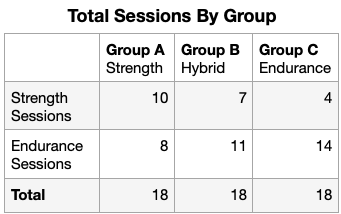By Rob Shaul
BLUF
This 5-week Mini-Study compared three programming methodologies to increase rucking speed.
Lab Rats were be broken into three groups. All groups performed a Strength Assessment, 6-Mile Ruck for Time @ 45 pounds, and 6-Mile Run Assessment during Week 1 of the mini-study, and repeated these assessments on Week 5 of the mini-study.
Each group performed different programming between the Week 1 and 5 assessment weeks.
- Group A (Strength Emphasis) trained strength 3 days/week, and endurance 2 days/week.
- Group B (Hybrid) trained strength 2 days/week and endurance 3 days/week.
- Group C (Endurance Emphasis) trained strength 1 day/week and endurance, 4 days/week.
A total of 17 remote lab rats completed the programming.
At the study’s conclusion, the Strength Emphasis (Group A) and Hybrid (Group B) programming significantly outperformed the Endurance Emphasis programming (Group C) to improve rucking speed performance on a 6-mile ruck assessment wearing a 45-pound backpack.
BACKGROUND & STUDY DESIGN
In previous research, MTI tested the fitness attributes (Ruck Deep Dive 1) which most correlated to rucking performance, and after a 6-week training cycle (Ruck Deep Dive 2), which increase in fitness attribute correlated best to an increase in rucking performance.
This mini-study (Ruck Deep Dive 3), compared the effectiveness of three different programming methodologies to increase rucking speed: (1) Strength Emphasis Cycle, (2) Endurance Emphasis Cycle, and; (3) Hybrid Cycle (strength and endurance-trained nearly equal).
This MTI “Mini-Study” took 5 weeks.
Weeks 1 and 5 were be the same for all groups:
-
-
- Monday: Relative Strength Assessment – 1RM Back Squat, 1RM Bench Press, Max Rep Pull Ups
- Tuesday: Total Rest
- Wednesday: 6 Mile Ruck for Time @ 45#
- Thursday: Total Rest
- Friday: 6 Mile Run for Time
-
Below was the Week 2-4 Daily Schedule for Group A (Strength)
-
-
- Monday: Strength – Back Squat, Bench Press, Pull Ups
- Tuesday: Ruck Intervals
- Wednesday: Strength – Back Squat, Bench Press, Pull Ups
- Thursday: Run Intervals
- Friday: Strength – Back Squat, Bench Press, Pull Ups
-
Below was the Week 2-4 Daily Schedule for Group B (Hybrid)
-
-
- Monday: Strength – Back Squat, Bench Press, Pull Ups
- Tuesday: Ruck Intervals
- Wednesday: Long Ruck or Run
- Thursday: Strength – Back Squat, Bench Press, Pull Ups
- Friday: Run Intervals
-
Below was the Week 2-4 Daily Schedule for Group C (Endurance)
-
-
- Monday: Strength – Back Squat, Bench Press, Pull Ups
- Tuesday: Ruck Intervals
- Wednesday: Long Run
- Thursday: Run Intervals
- Friday: Long Ruck
-
Including the Week 1 (pre) and 5 (post) assessments, here is the total session type breakdown per Group:
RESULTS & DISCUSSION
Below are the mini-study results:
Post-cycle ruck speed improvement for the Strength (A) and Hybrid (B) groups were 2-3x better than the Endurance group (C).
Overall, the Strength Group (A) improved its ruck speed by 8.5%, and the Hybrid Group (B) improved by 9.4%, while the Endurance Group (C) improved by just 3.2%.
These results were surprising. In past mini-studies, we’ve found a correlation between strength and rucking performance, but also between size and rucking performance. Because larger athletes also tend to be stronger, it makes sense that body size has a strong correlation to rucking performance. A 200-pound athlete rucking with 50-pounds is carrying 25% of his bodyweight, while a 150-pound athlete carrying the same 50-pound load, is moving with 33% of his bodyweight. It makes sense that the larger athlete would move faster.
However, that is just a one-time snapshot of rucking performance. With this study, we wanted to identify the type of programming that most improved rucking speed performance.
Going in, we hypothesized that the Endurance Emphasis Group (C) would see the most improvement in rucking performance. Rucking is certainly different than unloaded running because of the load, and as a result, demands more strength. However, we still consider rucking primarily an endurance activity.
But this was not the outcome. While the difference in rucking speed improvement between the Strength (A) and Hybrid (B) groups was not significant (just 1%), both groups significantly outperformed the Endurance Emphasis Group (C).
The lab rat attrition in this mini-study was significant. Each Group began the study with 14 lab rats. Group A finished with just 4, Group B finished with 7 and Group C finished with 6. These low subject numbers certainly could have affected the results.
However, despite this attrition and the low total study subjects, the relatively poor ruck speed improvement performance of the endurance group is significant and enough for us to conclude that Strength and/or Hybrid Programming outperforms endurance emphasis to improve ruck speed performance.
On the surface, you might assume that because the Strength (A) and Hybrid (B) groups trained more strength, they would have had more strength improvement and that this increase in strength would account for the greater improvement in rucking speed.
But this was not the case. As seen below, the strength improvements of the Endurance (Group C) lab rats was nearly equal to that of the Strength and Hybrid Groups:
If Group A and B’s increase in strength cannot account for their greater improvement in rucking speed over Group C, how can it be explained?
We’re not sure, but perhaps by total volume and the idea that the much greater endurance work completed by Group C was more fatiguing than the gym-based strength work by Groups A and B. Therefore, the Group C lab rats did not enjoy as much recovery, and as a result, their rucking speed did not improve as much.
But this is just a guess, and what is important is that Strength emphasis or Hybrid programming work better to improve rucking speed than endurance emphasis programming.
NEXT STEPS
Because the ruck improvement results for Strength (A) and Hybrid (B) programming were nearly identical, there is room for another mini-study comparing just these two programming approaches. Until then, we’ll work to focus on Hybrid programming for ruck performance in all future ruck speed new programming and updates.
Questions, Comments, Feedback? Email rob@mtntactical.com
You Might Also Like Geek Cycle: Leg Blasters Match Front Squat in Building Lower Body Strength




